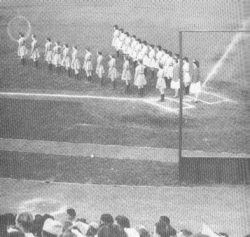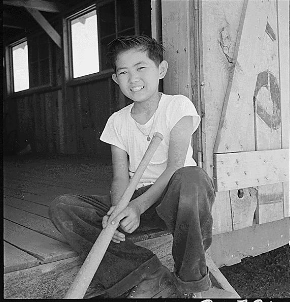Heart of a Nation - Baseball During the War
- Cat T. Gardiner

- Jul 9, 2016
- 5 min read
Updated: Jun 5, 2020
Hi-di-ho, friends! I'm back today dreaming of summer days and the sound of a baseball bat whacking the ball. The roar of the crowd and the way my thighs used to stick to the plastic seat way up in the stands! LOL Ah yes, I remember well my own enjoyment of a baseball game (of course I attended to ogle the players) but there was something special about attending, not watching on television. Was it the chocolate and vanilla ice cream? The peanuts? Cracker Jacks? Maybe it was the airplanes flying over Shea Stadium in Queens, competing for attention from the Jumbo Tron and the unstoppable 1986 Mets ball club. Or maybe it was just the sum of it all, put together on a summer night where the only thing that separated 45,000 attendees was what team you were rooting for.
I haven't attended a ballgame for years, not since experiencing the Tampa Bay Rays play in Tropicana Field - and that, for me, was a dud experience. Perhaps it was because I missed the thrill of a NY open-air stadium, even if the Rays were playing the Yankees.

I know, I know ... you're probably not a baseball fan, but you don't have to be for this article. Baseball was a great symbol during wartime. It was an American symbol and without it, the home front would have lost not only vital war bond sales and morale boosting games, but they would have lost a unifying heart of a nation, which had come together over a game with a bat and a ball. Baseball was an escape for laborers and professionals alike, mothers, fathers and children, people of color and ethnic diversity. It provided entertainment and distraction from the realities of war.
But don't get me wrong, there were rivalries and arguments on the home front - even in baseball. As a New Yorker, I can't not mention our wartime teams and the strong - opposing - loyalty of their fans. We had three: the New York Giants, the Brooklyn Dodgers (Dem Bums), and the New York Yankees (Bronx Bombers.) Countless arguments, no doubt, happened over many dinner tables or beside the radio. And I won't even get into the "Curse of the Bambino" (Babe Ruth) and that still ongoing rivalry between the NY Yankees and the Boston Red Sox.
In researching this one of many themes in A Moment Forever, I learned about something called the "Green Light" letter written by President Roosevelt. You see, in 1918 when America entered WWI, baseball ceased and was only brought back after armistice the year later. But FDR didn't want that to happen in 1942, especially given the knowledge that many ball players would be called up to fight. So on January 15, 1942, a little over a month after Pearl Harbor, he drafted a letter. "I honestly feel that it would be best for the country to keep baseball going. There will be fewer people unemployed and everybody will work longer hours and harder than ever before. And that means that they ought to have a chance for recreation and for taking their minds off their work even more than before." He believed that without baseball the American spirit would be dampened.
Yes, favorite ball players such as Joe DiMaggio and Ted Williams and 500 more left to serve in the most vital way, but baseball continued on with the same resolve as the nation did - with Victory in mind! The sport flourished, the stadiums were packed. Men even gradually warmed to change with the inception of the All-American Girls Baseball League in 1942 with spring training beginning in May of 1943. Do you remember the movie "A League of Their Own?" This wonderful film, which I recommend, brought history to light, determined not to let these incredible women fade into obscurity.
"Playing on the Theme of "All-American Girl," Wrigley promoted the image that the players were symbols of "the girl next door" in spikes. At the beginning of each game, the two teams formed a "V" for Victory from home plate down the first and third baselines followed by the playing of the Star Spangled Banner. The players played an even greater part in displaying patriotism by playing exhibition games to support the Red Cross and the armed forces, as well as visiting wounded veterans at Army Hospitals. Talent for the league was abundant, and it was soon evident that the women's high caliber of play was going to be the main drawing card for the fans." ~ Official Website of the All-American Girls Professional Baseball League Players Association
The women's 1945 season ended with having close to a half-million attendees in the stadiums. These girls endured not only the hardships of gender denigration, prejudice, and the rigors of long bus travel, athletic injuries, not to mention homesickness, but they paved the way, just as so many "Rosies" had in showing the world that not only "We Can Do It!" but also that girls could play baseball. In 1948 the AAGPBL was at its height with almost one-million attendees for the season. The league disbanded at the close of the 1954 season.

Not just women's baseball paved the way to change, so did the Negro Baseball League. Great ball players including Jackie Robinson had their start in the all-black professional league. Although segregated, teams such as the Kansas City Monarchs saw unprecedented prosperity as workers, with money to burn, filled the stadiums. These extraordinary athletes trail blazed across the color line when, finally, in 1946 baseball was desegregated and Jackie Robinson #42 was signed to the Brooklyn Dodgers, the first African American to play major league baseball. In this instance, baseball had trounced the military by becoming the first to break down barriers. It wasn't until 1948 that President Truman desegregated the Armed Forces following the brave uniformed service of 1.2 million African American men and women during the war.
Baseball is such an American way of life that never was it more apparent in that its fighting sons brought it with them to war, wherever they were. The boys picked up bats and gloves as they waited for flight assignments, they played, passing the time in POW camps, during R&R, and taught the locals the game. Our G.Is were our nation's team, fighting for victory and relieving the stress and fears through the love of the game. And when they couldn't play, they listened over armed forces radio.
I'll never get political here on the blog, but I will bring you the 1940s Experience. In fear of the "Fifth Column" between 1942 and 1946 almost 120,000 Japanese Americans living on the West Coast were relocated from their homes, incarcerated by the American government in armed camps in desolated places. But even that couldn't diminish the American spirit that ran in their blood, obvious by these images of baseball in the camps. It's important to recognize that thousands of honorable and decorated Japanese Americans served in our Armed Forces during the war, many of whom had family interred.
Baseball - It is a summer tradition, a glorious national pastime, coined as such as early as 1856. I'll leave you a WWII radio interview with the ballsy actress and baseball fan, Tallulah Bankhead. She gets what baseball means to an American and gives a message to the boys far from home. It was so much more than a game, it was embedded in the heart of a nation united. Keep 'Em Flying, my friends, Keep 'Em Flying!
























Comments